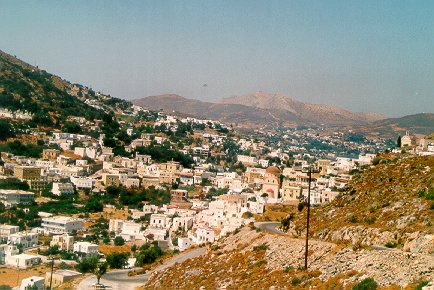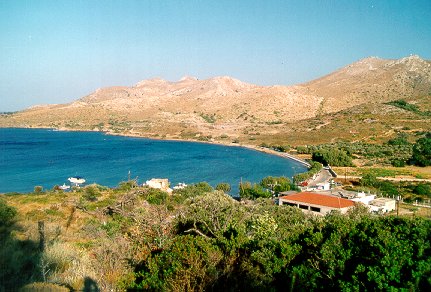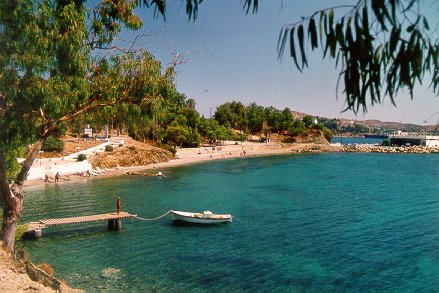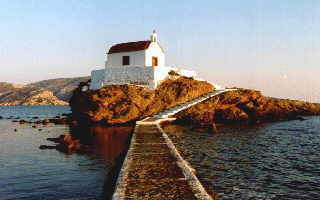|
Leros Island
Area: 53 sq. km.
 Leros
island, this little paradise situated in the Aegean sea, in
Greece, a place where visitors can find places to relax, to
have a very nice swimm, to have a very good meal, or to have
a crazy night partying. Leros offers so many possibilities
that everyone can find what he is looking for, and the
island keeps it's friendly image. Leros
island, this little paradise situated in the Aegean sea, in
Greece, a place where visitors can find places to relax, to
have a very nice swimm, to have a very good meal, or to have
a crazy night partying. Leros offers so many possibilities
that everyone can find what he is looking for, and the
island keeps it's friendly image.
The
goddesses of antiquity, who were distinguished for their
beauty, chose illustrious sites to build their palaces. This
is also what ARTEMIS did, the goddess of hunt. She chose an
extremely beautiful island, lying in the blue waters of the
Aegean, with vegetation, a lacy coastline, leeward bays and
kind-hearted people and there set up her throne. She chose
LEROS, a truly divine choice.
In order
for you to discover it just click on the buttons on your
left side, and you will get to know LEROS very well, and
knowing it once, you will never forget it !
The sea
sculpted the coastline of Leros with lavish artistry
giving it lacy shores, sandy beaches, protected harbours
and a multitude of little islands all around it. Nature
here has been endowed with lush vegetation and a landscape
of pleasant alternations. History has played an important
role on the island since ancient times. The people who
have lived there have shown it respect and built
monasteries, churches and mansions in a unique
architectural style.
This
island of 8.500 inhabitants lies in the Dodecanese, on the
southeastern adge of the Aegean, neat Patmos and Kos. It
has an area of 53 sq. km. and a coastline 71 km long owing
to the vigorous carving action of the sea. Today Leros
gives one the impression of being one of the last small
paradises left the visitor who is seeking rare and
untrammelled natural beauty. A serene beauty, which rests
the spirit and the senses together in an environment full
of harmony, so hospitable it feels intimate from the very
first moment.
 History:
Leros
strategic position in the southeast Aegean has given a rich
past in history. The first human traces on the island have
been detected at Partheni and belong to the Neolithic
period. This was an entire settlement and it has been dated
from 8000 to 3000 B.C.. Carian, Leleges, Phoenicians and
Cretans (led by Radamanthys, the brother of King Minos),
were its first inhabitants. In their tempestuous descent the
Dorians reached Leros and conquered it. Homer has it taking
part in the Trojan War along with Kalymnos and later the
historian Herodotus mentions that it developed close
political, intellectual and commercial ties with the Ionians
of Miletos. History:
Leros
strategic position in the southeast Aegean has given a rich
past in history. The first human traces on the island have
been detected at Partheni and belong to the Neolithic
period. This was an entire settlement and it has been dated
from 8000 to 3000 B.C.. Carian, Leleges, Phoenicians and
Cretans (led by Radamanthys, the brother of King Minos),
were its first inhabitants. In their tempestuous descent the
Dorians reached Leros and conquered it. Homer has it taking
part in the Trojan War along with Kalymnos and later the
historian Herodotus mentions that it developed close
political, intellectual and commercial ties with the Ionians
of Miletos.
During the
5th century Leros flowered intellectually. That was the
period of the satirical poet Dimodikos and the historian
Pherekydes. After the Persian Wars Leros became part of the
Athenian Alliance. The forces of Alexander the Great also
passed through Leros. This is confirmed by funerary steles
and coins from that period were found on the island.
Plutarch
also notes its important location for shipping, referring to
the captivity of Julius Caesar on the island of Farmako next
to Leros.
 During
Byzantine times magnificent Christian churches were built on
the island. Constantine the Great incorporated Leros into
the Theme of Samos. During that period the castle and the
Church of the Panayia (The blessed Virgin) were built as
well as the Castle of the Lepides, known today as
Paliokastro. So-called "Cyclopean" walls
have
survived in the area. There are exceptional Byzantine
monuments on the island such as the Early Christian church
at Partheni, the church of Ayia Varvara (St. Barbara), built
with sections of marble, column capitals, stone slabs and
other materials from the ruins of ancient Leros found there. During
Byzantine times magnificent Christian churches were built on
the island. Constantine the Great incorporated Leros into
the Theme of Samos. During that period the castle and the
Church of the Panayia (The blessed Virgin) were built as
well as the Castle of the Lepides, known today as
Paliokastro. So-called "Cyclopean" walls
have
survived in the area. There are exceptional Byzantine
monuments on the island such as the Early Christian church
at Partheni, the church of Ayia Varvara (St. Barbara), built
with sections of marble, column capitals, stone slabs and
other materials from the ruins of ancient Leros found there.
In Alinda,
as elsewhere, "tholaria" have been found, that is,
small domed dwellings dug into the slopes of hills, where
monks once took refuge. In 1314 Leros was occupied by the
Knights of St. John of Rhodes and they governed it
tyrannically until 1523 when the Turks took command of the
entire Aegean and plundered the islands. Despite the
difficult conditions of the Turkish occupation Leros did
manage to preserve a kind of autonomy and later when the
Greek Revolution of 1821 broke out Lerians were some of the
first to rise up.
 In 1830
all the Dodecanese were ceded to Turkey by the London
Protocol in exchange for Euboea. Then, during the period
1912-1943, it was taken over by the Italians. The whole
island was turned into an arsenal. Important defensive works
were carried out and military installations built with the
idea of turning Leros into an Italian naval base. A new town
was created at Lakki. Many buildings were pulled down in
order that new ones could be built in their place, with an
architecture unique in all of Europe at that time. In 1830
all the Dodecanese were ceded to Turkey by the London
Protocol in exchange for Euboea. Then, during the period
1912-1943, it was taken over by the Italians. The whole
island was turned into an arsenal. Important defensive works
were carried out and military installations built with the
idea of turning Leros into an Italian naval base. A new town
was created at Lakki. Many buildings were pulled down in
order that new ones could be built in their place, with an
architecture unique in all of Europe at that time.
During
World War Two, the Greek "Sacred Battalion"
liberated Leros after the Italian capitulation. This was
followed by two years of English occupation and then in
March, 1948, Leros, along with the rest of the Dodecanese,
was united with Greece.
|
>> Dodecanese Islands : Astypalea,
Halki, Kalymnos, Karpathos,
Kassos,
Kastelorizo, Kos,
Leros, Lipsi, Nisyros, Patmos, Rhodes, Symi,
Tilos.
|
|